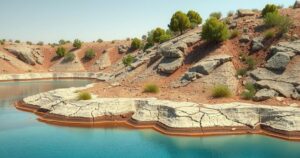Morocco’s Water Highway: A Temporary Solution Amid Climate Concerns

Morocco’s “water highway” project, redirecting surplus water from the Sebou River to urban areas, has cost $728 million and successfully supplied significant drinking water. However, concerns about its sustainability amid ongoing climate change and prolonged drought conditions remain, highlighting the need for adaptive strategies and alternative sources such as desalination.
Morocco is investing substantial funds, approximately $728 million, into a project termed the “water highway,” which aims to divert water from the Sebou River in the north to relieve water scarcity in southern urban areas, including the capital, Rabat, and Casablanca. Despite the immediate success, experts express concerns regarding the long-term sustainability and viability of the project amid climate change challenges.
The water highway, which involves the construction of a diversion dam in Kenitra and a 67-kilometre underground canal, has been operational since August 2023. It has reportedly delivered over 700 million cubic metres (24.7 billion cubic feet) of drinking water to major urban centers. However, recent conditions reveal that sustained surpluses of water from northern rivers may not be guaranteed due to increased evaporation and ongoing drought conditions affecting the region.
Morocco has faced significant drought for six consecutive years, leading to a steep decline in annual water supplies, dropping from 18 billion cubic metres in the 1980s to five billion cubic metres currently. Water Minister Nizar Baraka indicated that rainfall is highly concentrated, with 53 percent of annual precipitation occurring in only seven percent of the country’s territory, exacerbating regional disparities in water availability.
Climate experts warn of future reductions in rainfall supply, especially in northern basins designated for the water highway. Predictions suggest that northern areas will experience more intense climate effects over the next sixty years, potentially diminishing what is currently considered surplus water. Researchers urged for a reevaluation of the project and more efficient irrigation solutions to adapt to these changes.
In addition to enhancing the water management strategy, scholars advocate for increased investment in alternative water sources such as desalination plants, stating that although the water highway serves as a temporary relief, long-term solutions are vital to address the challenges posed by climate change. They emphasize the need for preparedness and adaptive strategies in response to the evolving climate and resource availability.
In conclusion, while Morocco’s “water highway” project successfully addresses immediate water supply concerns for major cities, the sustainability of this initiative faces scrutiny due to ongoing climate challenges. With significant reductions in water availability and predictions of continued drought and rising temperatures, it is critical to assess the long-term viability of this diversion strategy. Strengthening water management practices and exploring alternative water sources will be essential for ensuring future water security in the region.
Original Source: www.swiowanewssource.com






